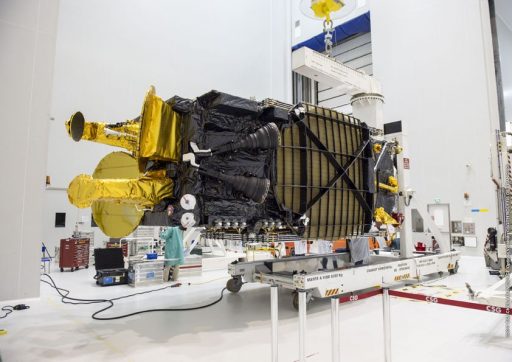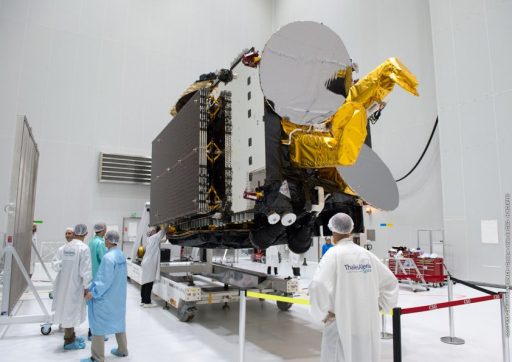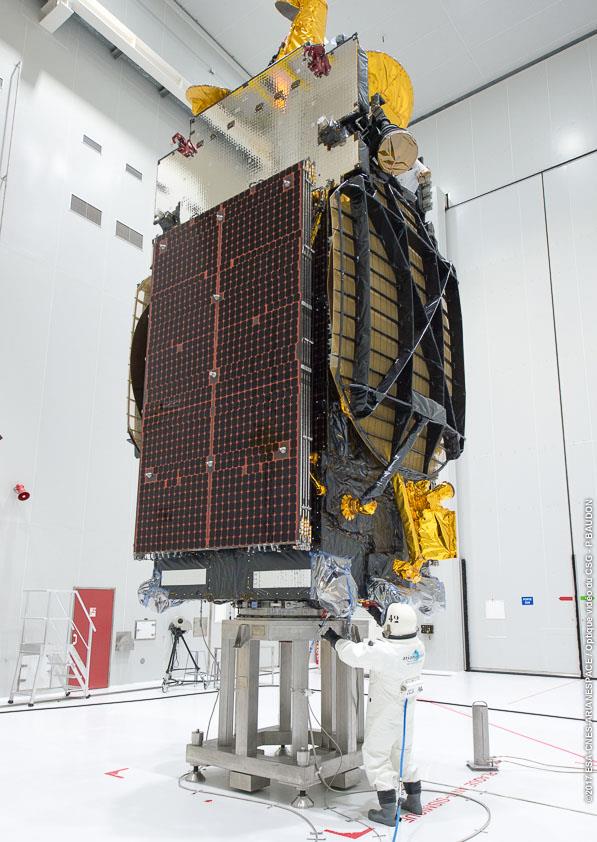Inmarsat-S / HellasSat 3

Inmarsat-S / HellasSat 3 (EuropaSat) is a powerful multi-band communications satellite shared by satellite operators Inmarsat based in London, and Hellas-Sat, a division of ArabSat. The satellite is outfitted with S-, Ku- and Ka-Band transponders to deliver Mobile and Fixed Satellite Services as well as Broadcast Satellite Services from a position in Geostationary Orbit where it can cover the entire European Union plus coverage areas in the Middle East and Southern Africa.
The project finds its roots in the original EuropaSat concept that was ordered by Inmarsat from satellite builder Thales Alenia Space in 2008 after receiving clearance for use of the 2 GHz S-Band frequency range under the European S-Band Application Process that had been announced a short time prior. Per the original design, the 5,700 Kilogram satellite was to host a large 12-meter S-Band antenna reflector and deliver 9 spot beams in two polarizations to provide mobile broadcasting services and two-way telecommunications.

Inmarsat put the EuropaSat project on hold in 2009 to seek external investors in to potentially spin the satellite off into a separate company partly owned by Inmarsat. The project’s revival did not come until 2014 when Inmarsat partnered with Hellas-Sat to share the cost of the satellite platform & launch. Under the new plan, the all-S-Band EuropaSat was re-designed into a multi-mission platform with an S-Band package for operation by Inmarsat under the EuropaSat designation and a Ku/Ka-Band payload for HellasSat to be marketed as HellasSat-3.
The change in payload design also required the satellite to step up one platform size from Thales Alenia’s Spacebus-4000C3 to the Spacebus-4000C4 that offers greater payload accommodations and more payload power. Per the agreement, Inmarsat and Hellas-Sat are splitting the cost for the satellite platform & launch vehicle while each company carries the full cost of their respective communications platform.

The Mobile Satellite Systems Payload operated by Inmarsat (EuropaSat) comprises a powerful S-Band package feeding three of the satellite’s six antennas, creating three large coverage zones – an Iberia Beam covering the entire Iberian Peninsula and portions of France, a Central European Beam and a Eastern Europe & Cyprus Beam.
The three spotbeams over the 2×15 MHz spectrum are intended deliver S-Band services to all 28 member states of the European Union plus Norway, Switzerland and eventually a non-EU United Kingdom. EuropaSat’s S-Band terminal offers enhanced mobile services through a hybrid network that combines satellite services with a Complementary Ground Component (CGC) infrastructure. Services provided by the S-Band payload are focused on aviation passenger connectivity as well as safety services for Public Protection and Disaster Relief across Europe.

The Iberian S-Band beam is provided by a 2.6-meter spherical antenna reflector on the East side of the spacecraft, the Central European beam is delivered by a 2.9 x 2.6-meter antenna on the West side and the Eastern European Spot Beam is provided by the satellite’s largest reflector of 3 x 2.6 meters, also on the West side.
The HellasSat-3 element of the condominium satellite comprises 47 Ku-Band transponders and one Ka-Band transponder to deliver Direct-to-Home Television and telecommunications services to Hellas-Sat’s existing customer base and tap into new markets in the Middle East and Southern Africa to continue a steady growth of the wholly-owned Arabsat division. HellasSat-3 provides reinforcements for the company’s existing user base plus room for additional capacity for HD and free to air channels and emphasizes the 39-degree East position as a prime DTH spot for European coverage.

The Ku-Band coverage zone over Europe is fed by a 2.6-meter diameter deployable reflector on the East side of the satellite while a pair of 1.3-meter dishes on the nadir (Earth-facing side) of the satellite provide the Middle East and Southern Africa beams with the former doubling as Ka-Band feeder for the high-throughput Ka-Band transponder. The multi-beam Ka-band payload is commissioned to provide capacity for broadband and business networks.
Inmarsat-S / HellasSat 3 stands 5.2 meters tall, has a launch mass of 5,780 Kilograms and sports two four-panel solar arrays to generate a payload power of 14.5 Kilowatts. Designed for the industry-standard 15-year service life, the satellite will operate from an orbital position of 39 degrees East.
The satellite was initially booked to ride into orbit on a SpaceX Falcon Heavy rocket for launch in 2016 and Inmarsat also secured an option for a Proton-M/Briz-M launch vehicle to safeguard for any further delays of SpaceX’s heavy lifter. However, with Falcon Heavy still waiting for a debut mission and Proton suffering an extended grounding due to engine problems, the satellite was moved in late 2016 to a mid-2017 launch on Europe’s Ariane 5 rocket, taking advantage of that vehicle’s schedule certainty to get the mission into orbit with only months of delays instead of years.

The flight-proven Spacebus-3000/4000 satellite series offered by Thales covers a range of satellite masses and payload accommodations, suitable for the entire spectrum of Geostationary communications satellites with up to 120 transponders and a payload power up to 16kW, using a 100-Volt power bus (4000 series).
Spacebus dates back to 1985 when the first Aérospatiale-built Spacebus satellite, flying under the Spacebus 100 designation was launched. Over the years, the capabilities of the satellites were expanded owed to more and more powerful launch vehicles becoming available, allowing transponders and equipment to be added to the satellites. Going through constant stages of modernization, Spacebus evolved into its 3000 and later the 4000 series which feature the same basic structure but different avionics systems. Thales provides an ITAR-free version of its satellite buses to allow spacecraft to launch on non-U.S. launch vehicles like the Chinese Long March rocket.

Spacebus 4000 uses a modular approach, with separate construction of the satellite platform and payloads for integration late in the manufacturing process. The 4000 series features upgraded avionics, transitioning from a 50-Volt power bus to a system running at 100 Volts. Also, a new integrated onboard computer with a higher flexibility than previous versions was added and the satellite bus employs star trackers specifically designed for use in Geostationary Orbit to provide excellent pointing data for attitude control.
Inmarsat-S / HellasSat 3 employs a hybrid propulsion system with chemical thrusters in use for the climb into Geostationary Orbit and an electric propulsion for Stationkeeping in Geostationary Orbit, providing the option of an extended mission beyond what would be possible with liquid-fueled thrusters alone.
The satellite uses an S400 main propulsion system and S10 attitude control thrusters, each delivering 10N of thrust. The S400 series built by Airbus Defence and Space are bi-propellant engines using Monomethylhydrazine and Mixed Oxides of Nitrogen as propellants. Depending on the version used, S400 provides 420 to 425 Newtons of Thrust with a specific impulse of 318-321 seconds.
To enable a mission extension of up to five years, the satellite is equipped with an electric propulsion system that will be used for stationkeeping maneuvers in Geostationary Orbit, primarily for North-South Stationkeeping that requires around 45m/s of delta-v per year. To that end, the satellite is outfitted with four SPT-100 Stationary Plasma Thrusters, each weighing 3.5 Kilograms and generating 83 millinewtons of thrust by accelerating a stream of Xenon ions in an electric field, achieving an exceptional specific impulse of 1,600 seconds.
